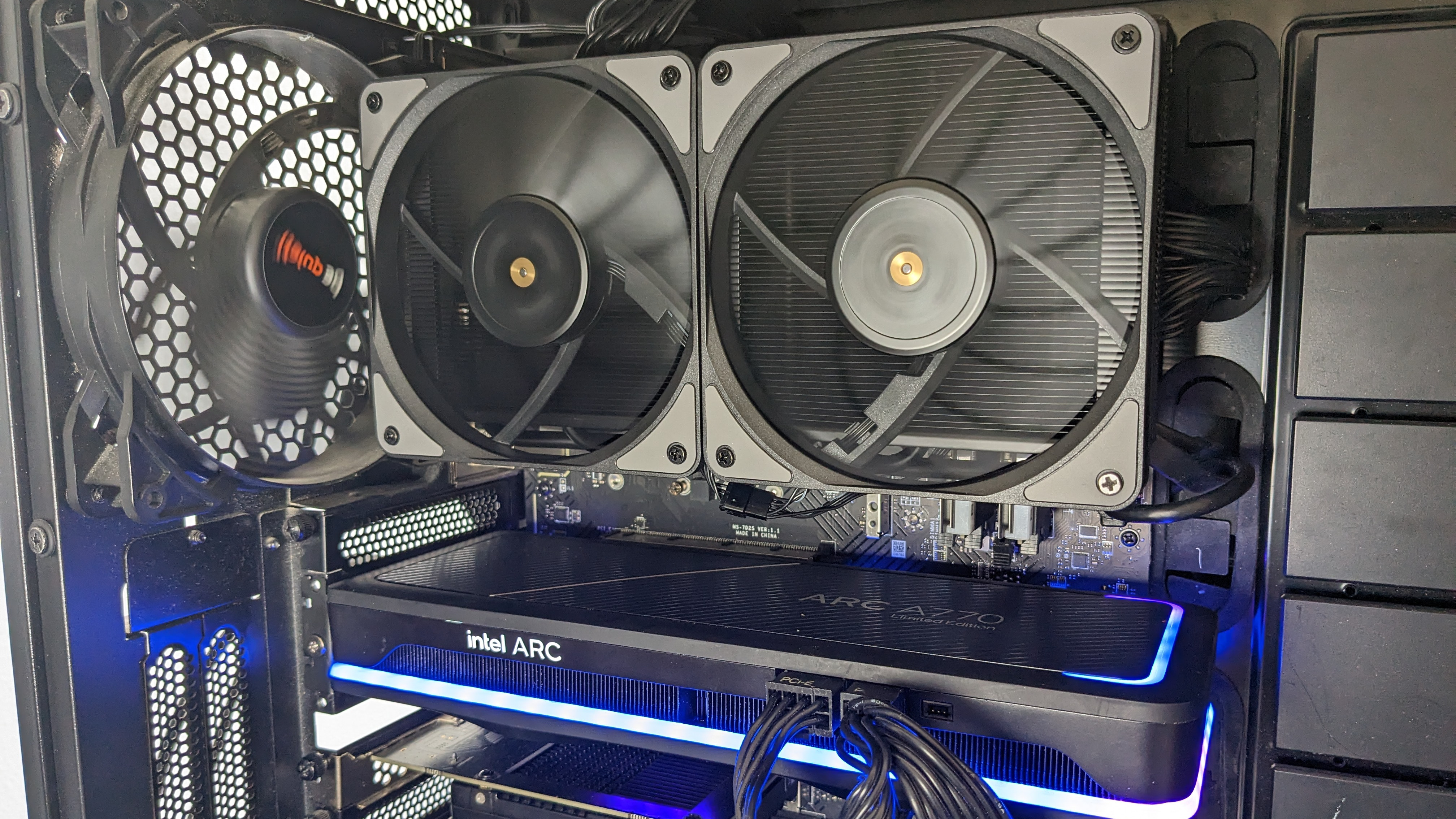
Jiushark is a name most American audiences probably haven’t heard of before, but the company is more well known in Asia. The company was founded five years ago, and the first part of the company’s name (jiŭ) translates to the number nine in Mandarin, and its motto is “simplicity first, back to basics.”
We’ve covered Juishark in the past, highlighting some of its unique products like the Jiushark M.2 Three, an M.2 SSD cooler that uses a dual heatpipe radiator and fan, much like a mini CPU cooler.
Here we’re looking at Jiushark’s JF13K Diamond, a unique air cooler with an innovative form factor which incorporates top down air cooling through a 240mm radiator. Is this new design actually effective enough to make our list of best coolers, or is it just designed to grab attention? We’ll have to put it through testing to be sure, but first we’ll look at the features and installation of this cooler.
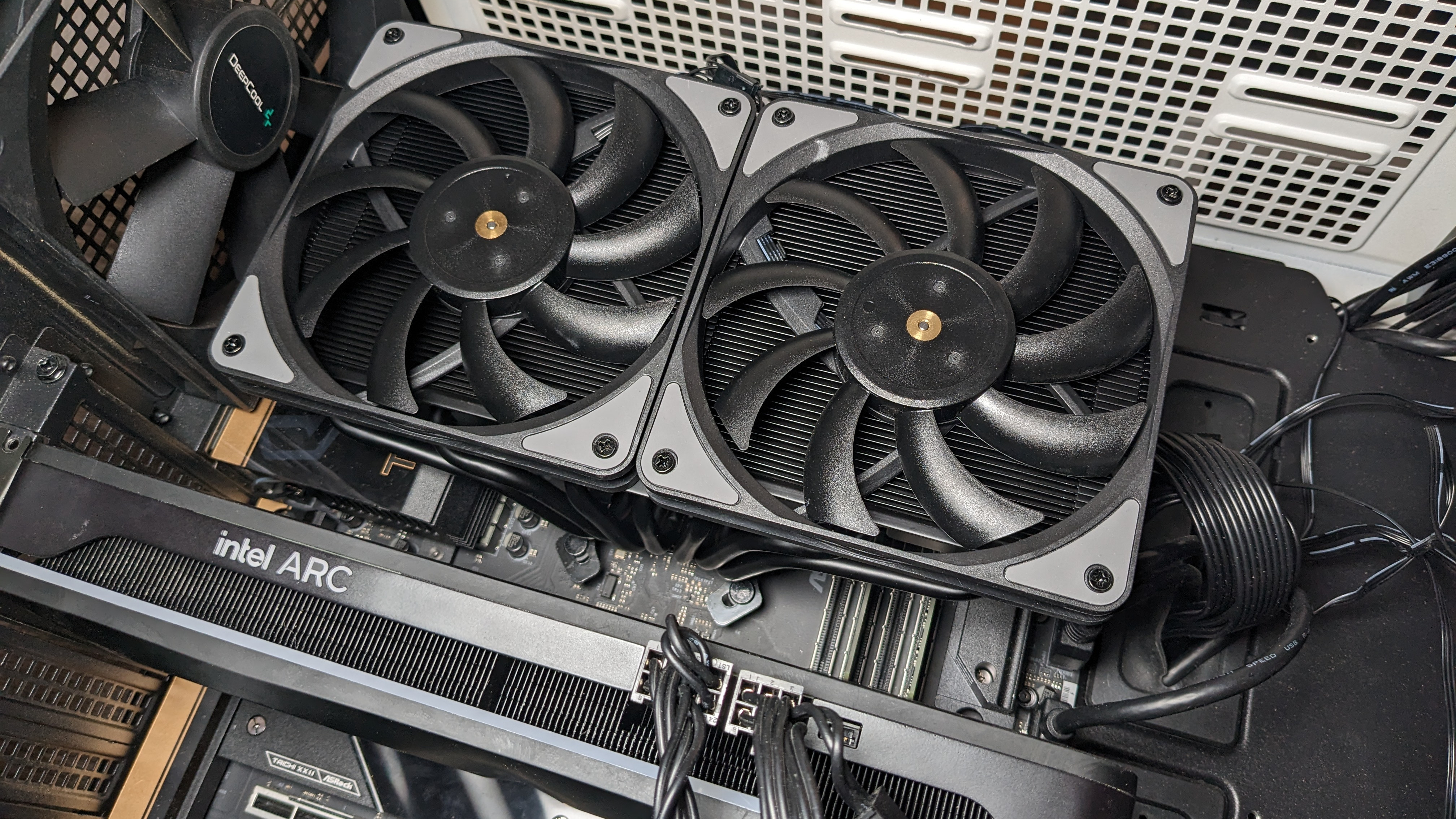
Cooler Specifications
Packing and Included Contents
Jiushark’s JF13K Diamond arrives in a package similar in size to a shoebox.

Included with the package are the following:
- 240mm radiator with seven heatpipes
- Two slim 120mm fans, pre-installed
- Thermal Paste
- Mounts for all modern CPU sockets (including AM5 & LGA1700)
- Replacement AM5 Backplate + Torx screwdriver
- Intel Blackplate
- Screwdriver bolt adapter
Installation
The installation of the JF13K Diamond is fairly simple and straightforward, but I wouldn’t describe it as easy. While it can be installed by a single person, it’s less of a hassle on Intel platforms if you have someone to help.
The installation process is fairly similar on both AMD and Intel platforms.
If you’re using an AMD AM4 or AM5 platform, you’ll need to first remove the default backplate. Use the included torx screwdriver to loosen the screws of the CPU socket and the backplate will come right off. Then press the replacement backplate against the motherboard and re-secure the torx screws.
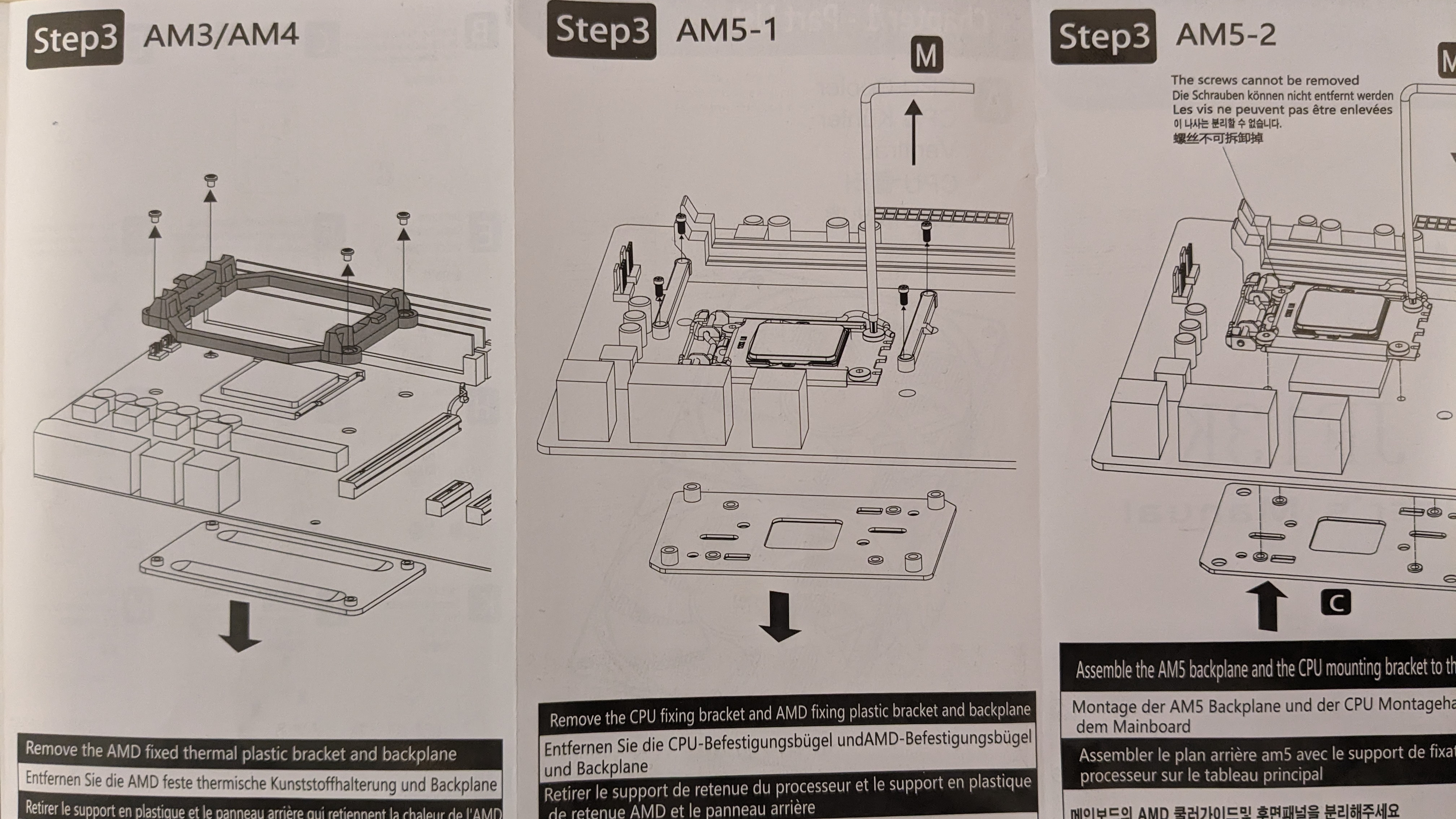
The next step is to prepare the mounting bars. You’ll first want to take the long screws and secure them to the mounting bars with the included standoffs.

Use the four included screws to secure the mounting bars to the base of the cooler.

The next step is the most difficult: while pressing the cooler against the motherboard, you’ll need to secure the cooler to the backplate using the included bolts. This is a little easier to do on AM5, as the backplate is already secure when you do this – but with Intel you’ll need to hold both the backplate and the cooler in place while you secure the bolts.
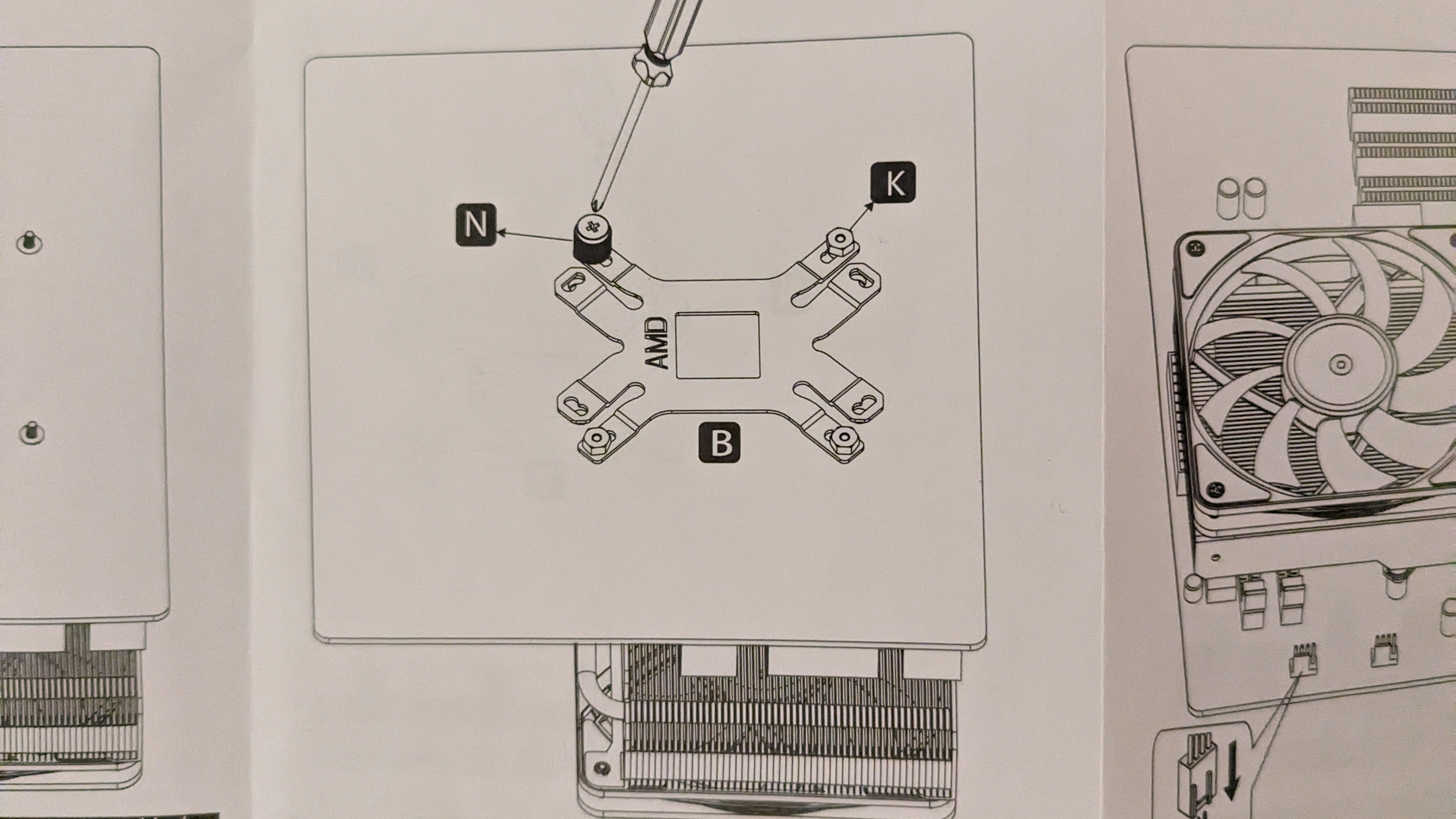
Jiushark includes an adapter which allows you to use a screwdriver to secure the bolts if you prefer, but I threaded them by hand without any issues.

Features of Juishark’s JF13K Diamond
240mm heatsink with top-down cooling
The JF13K Diamond has an innovative 240mm heatsink with top-down cooling. Top-down cooling means the product also provides airflow to the VRM heatsinks and DIMMs surrounding the CPU.
Full RAM Compatibility
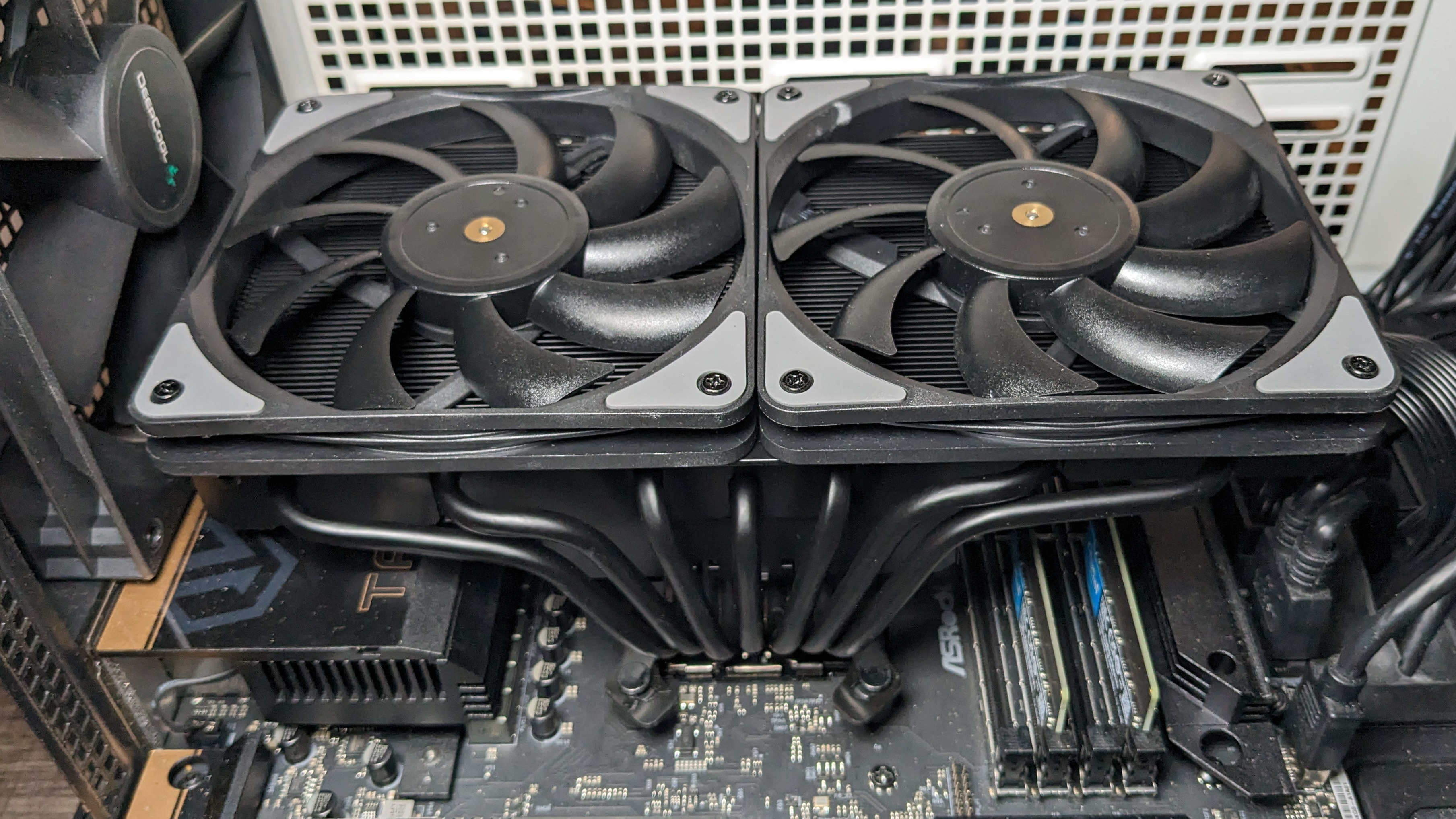
While the JF13K hovers above your RAM, it leaves 2.32 inches for DIMMs, which is enough room for Corsair’s Dominator DIMMs, and likely almost anything else, so you shouldn’t have to worry if your RAM is too tall.
Small Form Factor (SFF) Compatibility
With a total height of only 92mm (3.62 inches), the JF13K Diamond is ideal for space-constrained SFF computer cases.
7 Copper Heatpipes
To ensure maximum cooling capacity in this unique form factor, Jiushark includes 7 heatpipes with the JF13K Diamond.
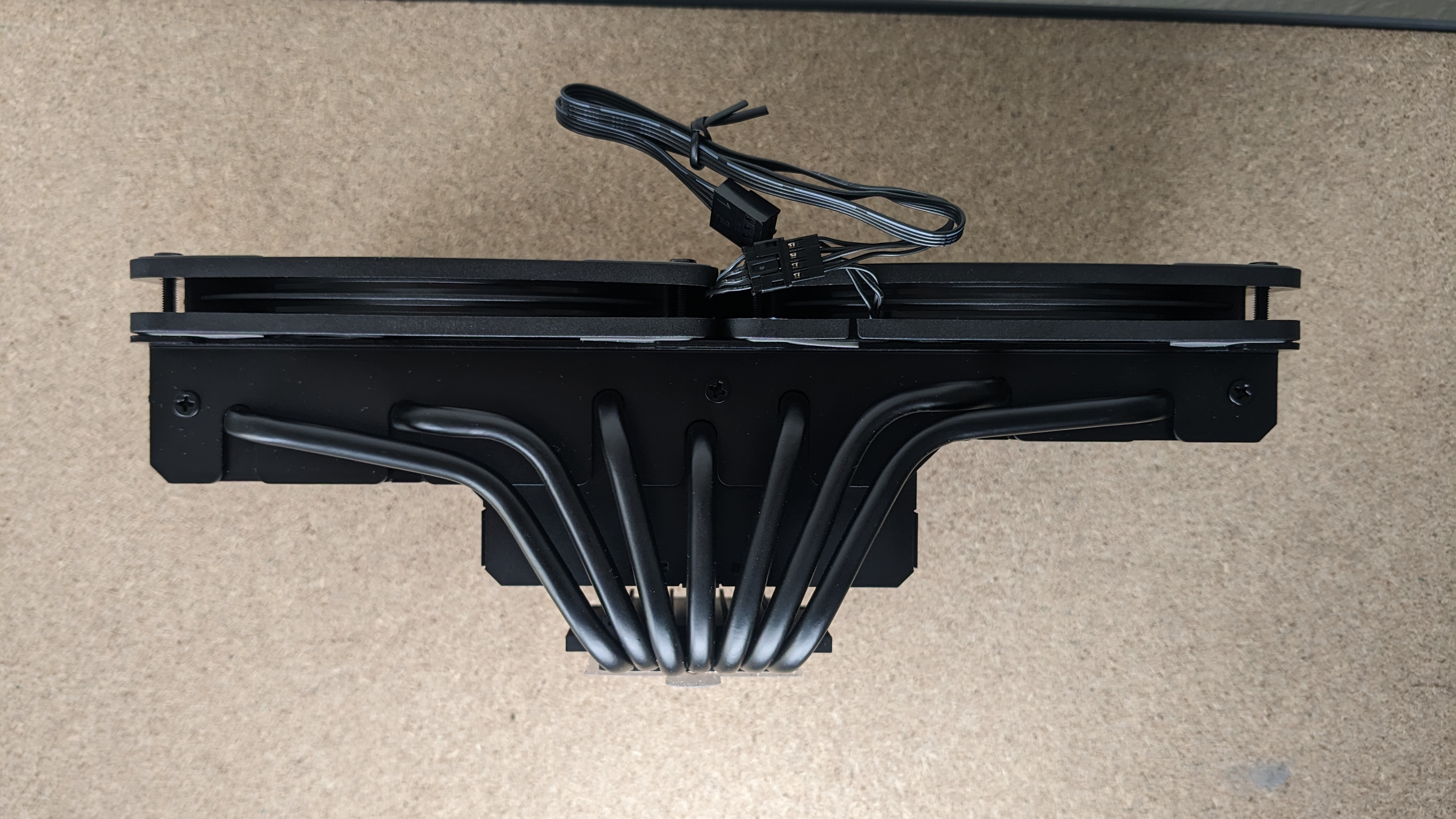
2x Slim 120mm fans
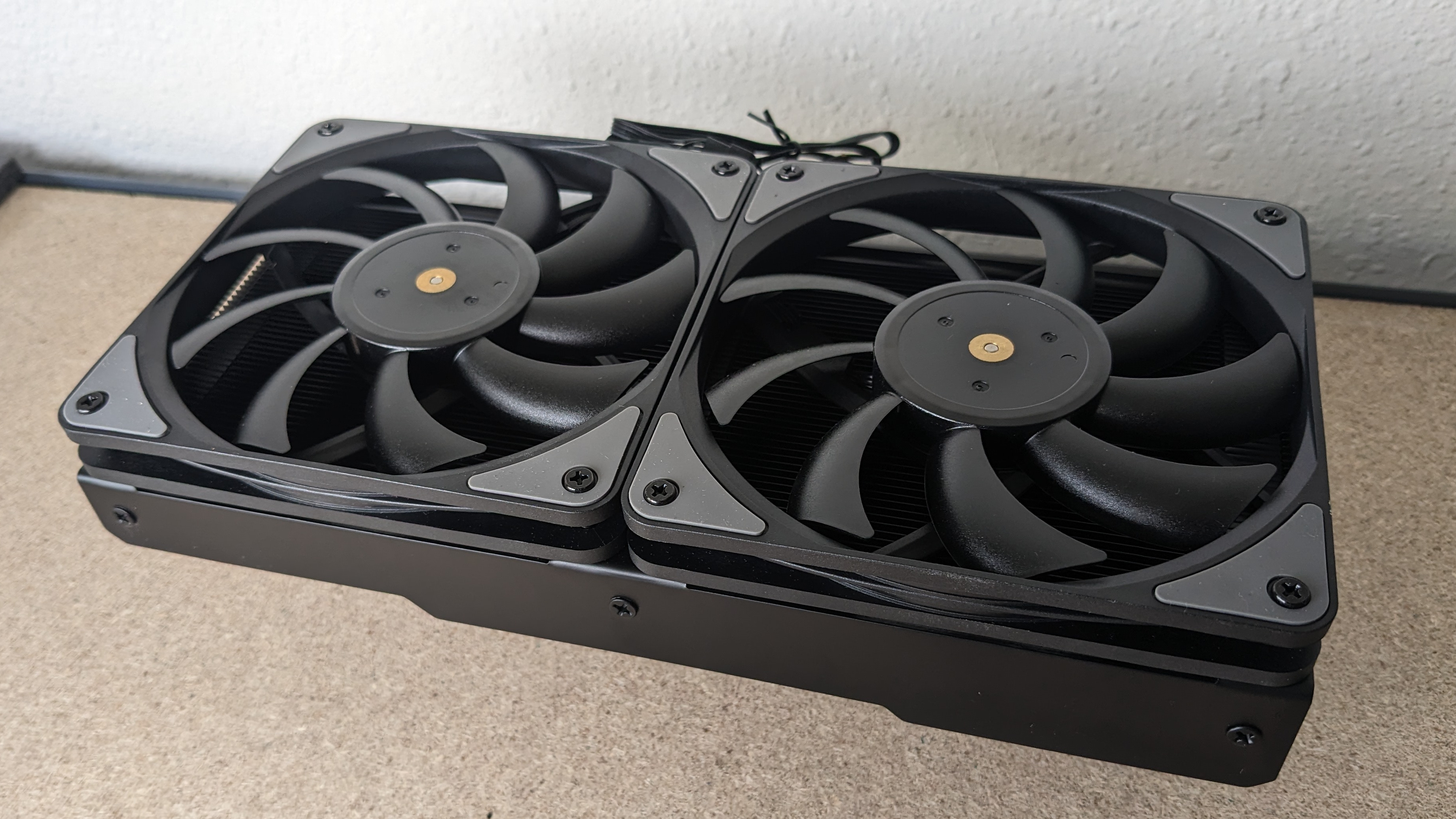
There’s more to a cooler than just the heatsink or radiator. The bundled fans have a significant impact on cooling and noise levels. Pre-installed to the JF13K Diamond are two slim 120mm fans, measuring only 15mm (0.59 inches) in height.
Many users have asked me if upgrading to stronger fans can increase the FJ13K Diamond’s cooling capacity. We’ll examine this subject in the thermal results section.
Foreword
Modern CPUs, whether Intel or AMD, are difficult to cool in intensive workloads. In the past reaching 95C+ on a desktop CPU might have been a cause for concern – but with today’s processors, it is considered normal operation. Similar behavior has been present in laptops for years due to cooling limitations in tight spaces.
Since last fall, Tom’s Hardware has brought you cooling reviews using one of the most power-hungry desktop CPUs on the market – Intel’s flagship i9-13900K. To give you an idea of what it takes to cool Intel’s behemoth, we’ve tested it with a variety of coolers, from basic low-end air coolers like the Amazon Basics CPU cooler to high-end 420mm AIOs such as Corsair’s iCUE H170i Elite.
While it’s nice to see how Intel’s flagship responds to different levels of cooling, those results don’t always correlate with lower-tier CPUs. So with today’s review, we’ll be switching our focus to two CPUs more commonly purchased by end users – AMD’s Ryzen 7 7700X and Intel’s i7-13700K CPUs.
LGA1700 Socket Bending
Note there are many factors other than the CPU cooler that can influence your cooling performance, including the case you use and the fans installed in it. A system's motherboard can also influence this, especially if it suffers from bending, which results in poor cooler contact with the CPU.
In order to prevent bending from impacting our cooling results, we’ve installed Thermalright’s LGA 1700 contact frame into our testing rig. If your motherboard is affected by bending, your thermal results will be worse than those shown below. Not all motherboards are affected equally by this issue. I tested Raptor Lake CPUs in two motherboards. And while one of them showed significant thermal improvements after installing Thermalright’s LGA1700 contact frame, the other motherboard showed no difference in temperatures whatsoever! Check out our review of the contact frame for more information.
Testing Methodology
All testing is performed in a room with a 23 degrees Celsius ambient room temperature. Multiple thermal tests are run on each CPU to test the cooler in a variety of conditions, and acoustic measurements are taken with each result. These tests include:
1. Noise normalized testing at low noise levels
2. “Out of the box”/default configuration thermal & acoustic testing
a. This means no power limits on Intel’s i7-13700K, and AMD’s default power limits on AMD’s Ryzen 7 7700X.
b. Because CPUs hit Tjmax in this scenario, the best way to compare cooling strength is by recording the total CPU package power consumption.
3. Thermal & acoustic testing in power-limited scenarios
a. With Ryzen 7 7700X, I’ve tested with limits of 95W and 75W enforced.
b. On Intel’s i7-13700K, I’ve tested with limits of 175W and 125W enforced.
The thermal results included are taken during 10-minute testing runs. To be sure that was sufficiently long to tax the cooler, we tested both Thermalright’s Assassin X 120 R SE and DeepCool’s LT720 with a 30-minute Cinebench test with Intel’s i9-13900K for both 10 minutes and 30 minutes. The results didn’t change much at all with the longer test: The average clock speeds maintained dropped by 29 MHz on DeepCool’s LT720 and 31 MHz on Thermalright’s Assassin X 120 R SE. That’s an incredibly small 0.6% difference in clock speeds maintained, a margin of error difference that tells us that the 10-minute tests are indeed long enough to properly test the coolers.
Testing Configuration – Intel LGA1700 Platform
Testing Configuration – AMD AM5 Platform
Unique tests performed with Jiushark’s Cooler
Like many of you reading this now, I first heard of the JF13K Diamond after watching Gamers Nexus’ review of it. Steve’s review left me with two questions:
1. Does the top-down design help with cooling RAM DIMMs?
Answer: Not at stock speeds.
I ran memtest64 for twenty minutes when this cooler was installed on Intel’s i7-13700K using the RAM’s XMP profile, and compared it to a traditional air cooler. The DDR4 DIMM temperatures rose 4-5C. While I can say it doesn’t help reduce temperatures in stock configuration, it might be of benefit if the RAM modules were overclocked.
2. Can stronger fans improve the thermal capacity of this cooler?
Answer: Technically yes, but it’s not worth it.
Being paired with slim 15mm fans of relatively low noise levels, many people (myself included) wanted to know if upgrading the cooler’s fans could improve its cooling performance. The non-stock fans I tested were Cooler Master’s newly released Halo 2 series fans – but they had no impact on cooling capacity whatsoever.
Since those fans didn’t improve performance, I pulled out some of the strongest fans I have available. Cougar’s MHP 120 fans feature 4.24 mm-H20 static pressure and 82.5 CFM of airflow. Even with these very strong fans, cooling performance only improved minimally – increasing by only 10W of cooling capacity with Intel’s i7-13700K.
So while you technically can eke better performance out of Jiushark’s cooler, it’s really not worth doing so. The default slim 120mm fans are more than strong enough for Jiushark’s cooler.
Intel i7-13700K Thermal Results
Louder fans only improve cooling by a limited amount in most cases, as you’ll see from our full-speed results, and as such it’s important to test coolers at settings where noise levels are equalized. While some might not mind loud fans, many folks prefer to have systems that run quietly.
Thermal Results with noise normalized to 38.2 dBA
Jiushark’s unique cooler performs decently in this scenario, on par with Thermalright’s Frost Spirit 140, cooling an average of 171W during testing. It ended the test still cooling over 150W, which is strong enough for most workloads common users will face.
If you need full performance for heavy workloads run over long durations, you’ll want stronger cooling, but for most users, the Juishark JF13K Diamond and other air coolers will provide sufficient cooling for any tasks they would encounter.
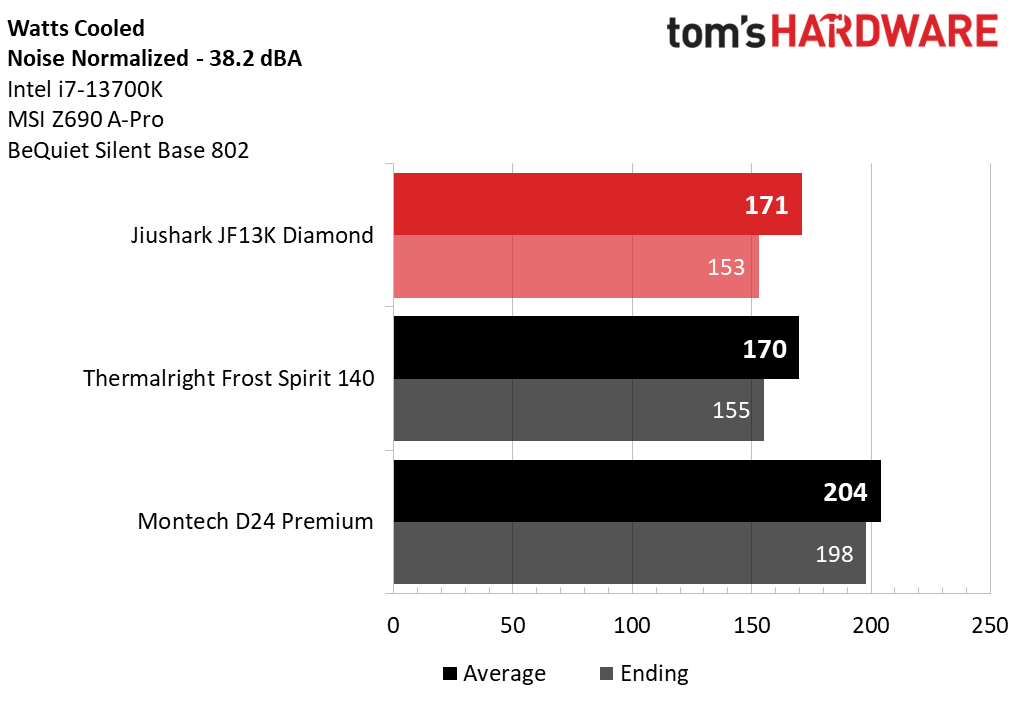
No Power Limits Thermal Results
If you don’t have power limits enforced on Intel’s i7-13700K, it will hit TJMax (peak CPU temperature) and thermally throttle with even the strongest of air coolers. In this test, we measure the total amount of watts the cooler is able to cool from the CPU.

With an average of 189W during the course of testing, Jiushark’s offering cooled 88% of what the stronger, larger dual tower coolers were able to dissipate. Performance doesn’t scale very well with additional power past a certain point in power consumption, so this reduction in cooling capacity will result in very little lost performance – we’re talking single-digit performance differences in actual benchmarks.

Noise levels are great with all coolers I’ve included for this review. With a measured maximum total system noise of 45.6 dBA with Jiushark’s FJ13K Diamond installed, noise levels were moderate, not loud.
175W Cinebench Results
Most coolers on the market are able to keep Intel’s i7-13700K under its peak temperature if the power consumption is limited, so for this test we’ll be looking at the CPU’s actual temperature. The Jiushark cooler was able to pass this test, but barely – this pushed the cooler to its maximum and caused it to reach TJMax near the end of testing.
The noise results in this test are the same as the previous test, because all three coolers reach 80C or higher in this scenario where the fan speeds are tied to the default fan curve of MSI’s Z690 A Pro.

125W Cinebench Results
The lowest power limit I test with Raptor Lake CPUs is 125W. This is a high enough limit to allow the CPU to maintain its base clock speeds, even in the most intensive tests, and most coolers should be able to keep the CPU below Tjmax – even low-end coolers.

Jiushark’s offering runs a bit warmer than the competition here, but at only 53C above the ambient temperature, it’s nothing to worry about. However, it does run louder than the other coolers in this scenario, due to its reduced cooling capacity compared to a traditional desktop cooler.
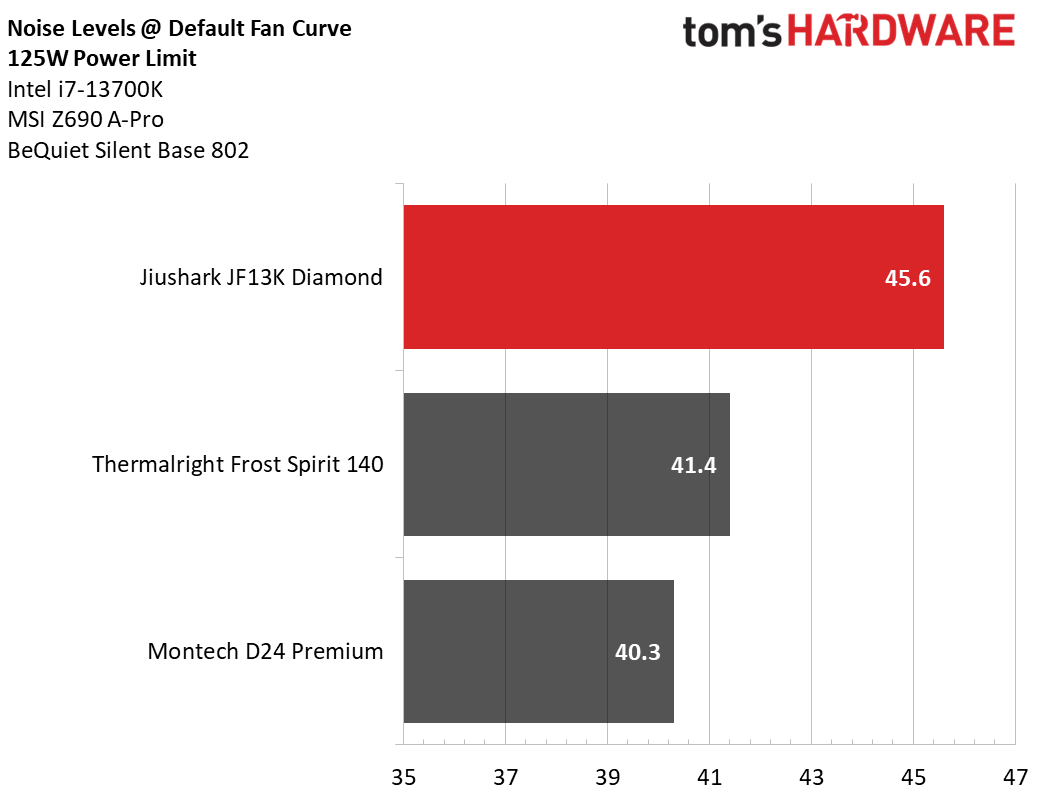
AMD Ryzen 7 7700X Thermal Results
It’s great to see how coolers perform with hotter CPUs like Intel’s i9-13700K, but that performance doesn’t always directly translate to how other CPUs will operate with the same coolers. With today’s review, I’ve expanded my coverage to include AMD’s Ryzen 7 7700X to show how coolers might respond with other commonly used CPUs.
Thermal Results with noise normalized to 36.4 dBA

When paired with AMD’s Ryzen 7 7700X, Jiushark’s JF13K provides 92% of the cooling capacity in comparison to Montech’s D24 Premium air cooler. This is a much better result than earlier with Intel’s i7-13700K, where it only provided 83% of the cooling capacity of Montech’s D24 Premium.
Maximum Cooling Capacity with maximum fan speeds
Our next test of the cooler’s maximum cooling capacity, done by allowing its fans to run at full speed. Jiushark’s offering does very well here, providing 93% of the performance of the higher-end Montech D24 Premium air cooler.
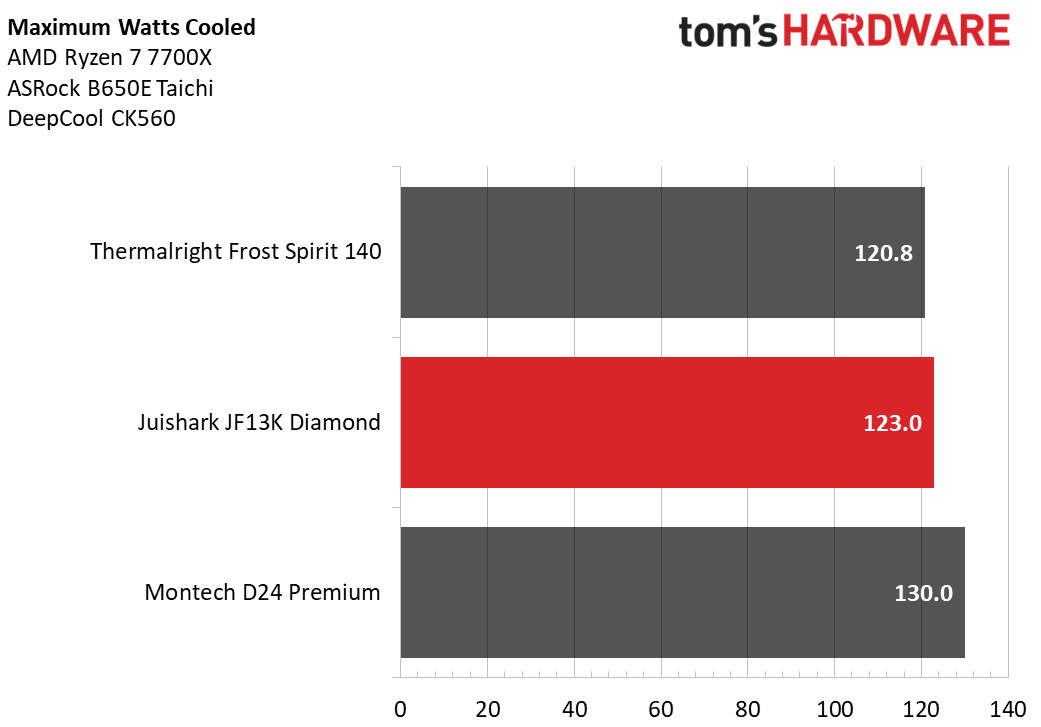
The Diamond achieves this cooling capacity with a total system noise of 45.6 dBA, which is a moderate noise level but, again, not loud or distracting.

Thermals and Acoustics with a 95W Power Limit
Not every task will force the CPU to use its full potential or maximum power draw, so it’s good to test coolers in a variety of power limits. With an average of 56C over ambient, the Jiushark trails the comparison Thermalright and Montech air coolers here by only a few degrees.
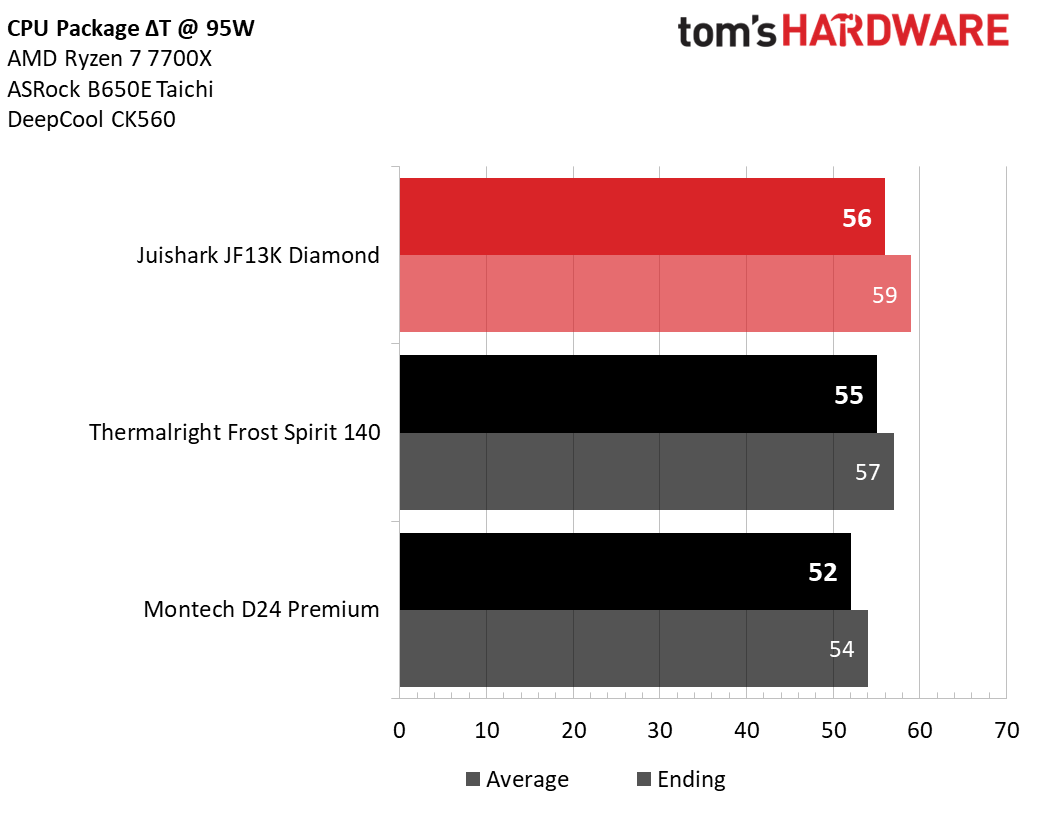
Noise levels aren’t changed in this scenario with Jiushark’s cooler, because the CPU still peaks at above 80c, causing the fans to run at full speed.

Thermals and Acoustics with a 75W Power Limit
With power draw reduced to 75W on AMD’s Ryzen 7 7700X, this thermal load shouldn’t be difficult for most coolers to accomplish. This is roughly the amount of power the Ryzen 7 7700X CPU will use during gaming, and it’s also the maximum power consumption of AMD’s non-X Ryzen 7 CPU.

At this lower level of power consumption, there’s no advantage of using a stronger cooler – Jiushark’s JF13K Diamond provides the same performance as Montech’s D24 Premium. It’s actually outperforming Thermalright’s Frost Spirit 140 in CPU temperatures, which was surprising. To be sure there was no user error involved, I retested the Frost Spirit, but the results were the same!
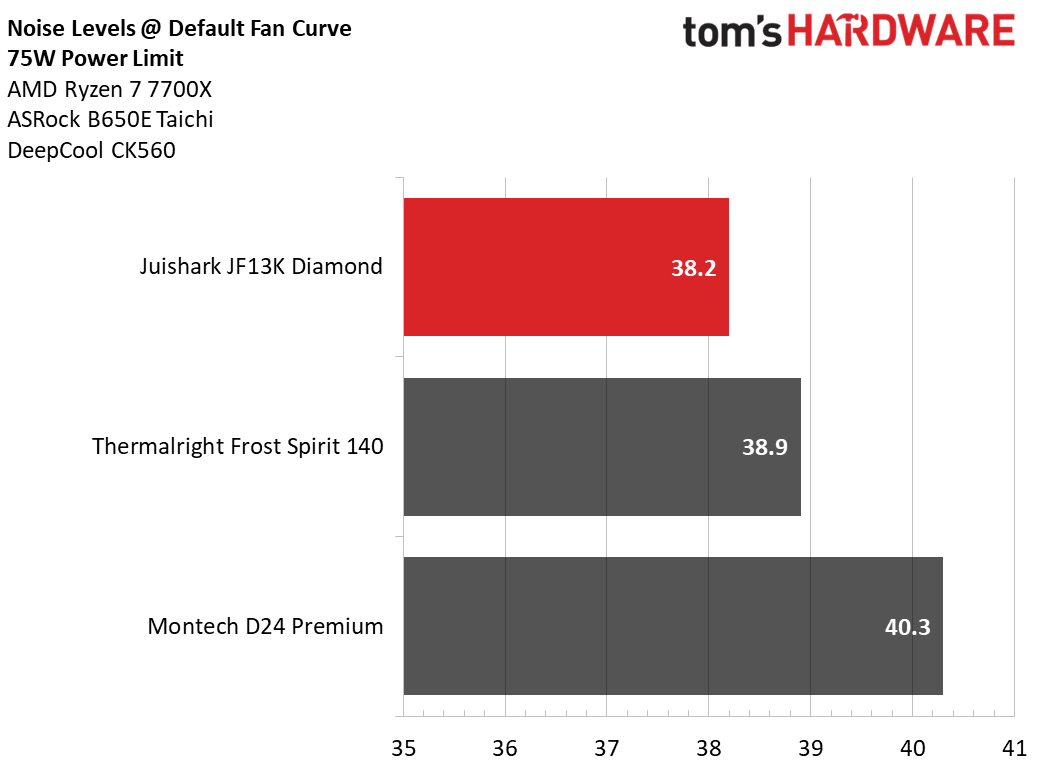
Acoustic levels are absolutely superb at this lower level, with Jiushark’s JF13K Diamond only reaching 38.2 dBA – which is near silent to most people’s hearing.
Conclusion
At $40 USD, this cooler is an absolute bargain for those builds that need a low-profile cooler. The only downside to this cooler is that availability may be limited in the United States and Europe. If you want this cooler at the moment, you’ll likely have to import it via AliExpress or Taobao.
I’m giving this cooler my full recommendation because Jiushark’s JF13K is the first cooler I’ve tested in a long time which truly pushes the bar in terms of innovation. Its unique form factor allows it to fit in the most space constrained of SFF cases, and at the same time it still has room for taller RAM modules. It’s best paired with CPUs like AMD’s Ryzen 7 7700X, but it also performs well with stronger CPUs like Intel’s i7-13700K.







